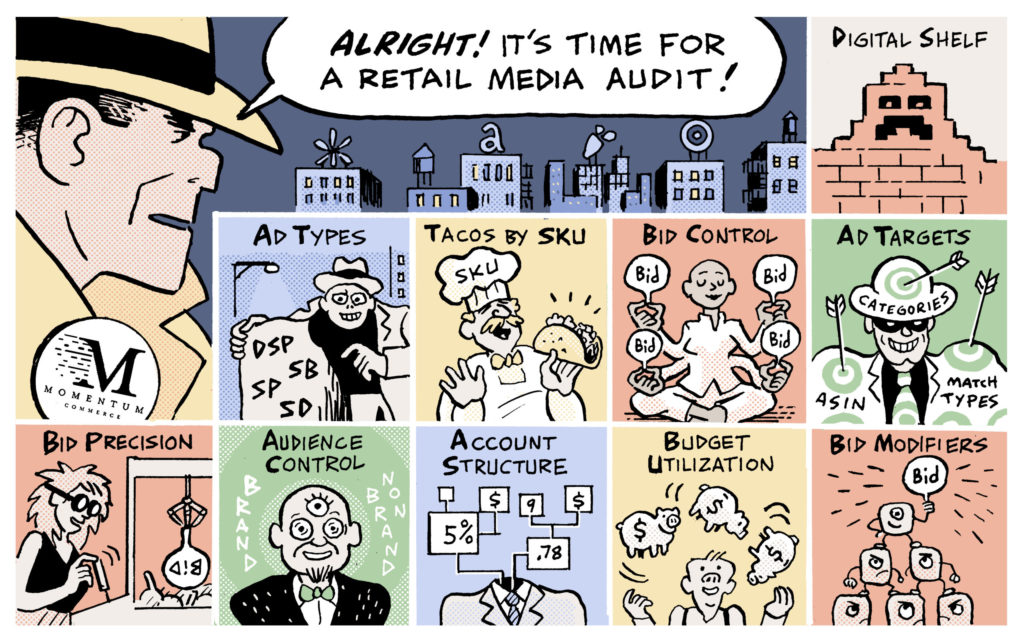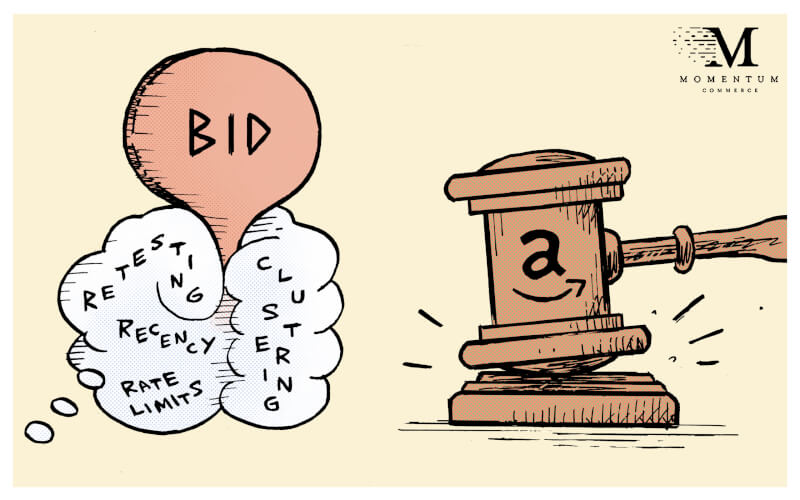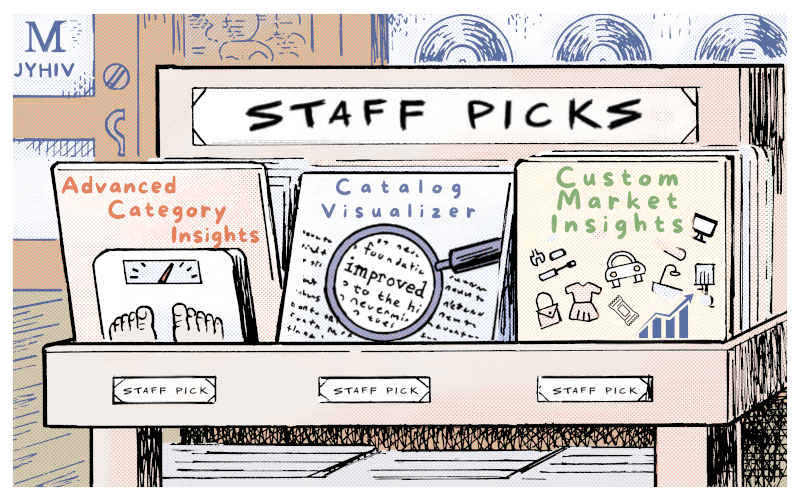
“It’s All in the Details” – 10 Checks for an Amazon Ads Audit
The combination of proliferation of Retail Media platforms with the increase of monetization on the platforms themselves (largely driven by advertising), has resulted in the pressure on brands to not only increase advertising investment but to also become more strategic with overall strategy. What does this mean for brands looking to win the Online Shopper? It means they need flawless execution of advertising programs. The first step in diagnosing the overall health of your program is to conduct a “soup to nuts” Advertising Audit. At Momentum Commerce, we combine our custom data sets with our deep domain expertise to conduct 10-Point Advertising Audits to help brands understand their current SWOT (strengths, weaknesses, opportunities and threats) position.
1. Digital Shelf “What is the competition doing? How much room is there to grow?”
What It Is: The digital shelf is the way products are displayed online. As a shopper, similar to your experience in-store when shopping, you want to be able to quickly find the product you’re looking for online when you begin your search. As a brand, you want to make sure the search → product process is quick, without any disruption from your competition.
Why It Matters: According to Amazon, 70% of shoppers never click past the first page of search results and 35% of shoppers click the first product displayed on the search page. In short, if you want to win the Shopper on these competitive marketplaces, you need to own the first page of search results. Understanding where your products are displayed in relation to competitors (share of voice) and how they are displayed in comparison to competitors (pricing, content, etc) is the foundation of which your advertising strategy should be built around.
2. Account Structure “Does my structure enable granular insights and management?”
What It Is: Account Structure is the architecture that dictates how your advertising budgets and financial objectives (bids) are associated with the products you wish to advertise (your assortment) and the consumers you wish to advertise them to (keywords searched, product pages viewed, etc.).
Why It Matters: A well-thought out and disciplined approach to Account Structure is critical to establishing control over your advertising program and enabling flexibility as business fundamentals evolve (price changes, margin changes, stock changes, competitive changes, financial goal changes, etc.. etc.. etc..). In many cases, account structure can also be a handy way to aggregate performance data across various themes for the purposes of reporting. (Momentum Commerce recommends Product-Level Campaign Structure, read why that’s important here: The Importance of Product-Level Controls)
3. TACOS by ASIN “Am I supporting my full catalog appropriately?”
What It Is: TACOS (Total Advertising Cost of Sale) is the ratio of ad investment vs. total sales (paid and organic combined). Traditionally for Retail Media, businesses will invest between 10%-15% of their total sales on advertising, depending on margins, brand strength, objectives and other factors. Retail Media platforms are rapidly transforming into advertising-driven marketplaces. Much like Google Shopping’s evolution from the free “Froogle” of the early 2000s to the entirely Pay-to-Play Google Shopping we know today, the Retail Media platforms are building a toll road to consumers in the form of Sponsored Ads.
Why It Matters: Different products in your catalog will have different objectives. For example, a new product launch will likely have a goal of quick market penetration and high sales volume, whereas your #1 selling product will likely have a goal of maintaining your BSR or Amazon’s Choice Badge. The advertising strategy needed to achieve these differing objectives will not be uniform. New product launches require high advertising investment in order to activate the Flywheel effect, whereas with your #1 selling product you may not need to spend as in advertising once you have optimal organic visibility. The only way to fully understand the impact of your advertising is by closely monitoring TACOS by ASIN. Granularity=control.
4. Ad Types “Am I using all ad types optimally?”
What it is: Amazon Advertising offers 3 distinct ways you can get in front of your audience. 1. Sponsored Products (SP) 2. Sponsored Brands (SB) and 3. Sponsored Display (SD). Sponsored products more than likely will be where the lion’s share of your spend and traffic are derived. We generally see this coming through in the range of 75% of your traffic. Sponsored Brands (the 3 ads at the top of an Amazon Search), generally account for approximately 20% of your overall spend. Finally, we see Sponsored Display taking up 5% of an accounts budget, which is heavily driven by retargeting within the Amazon ecosystem.
Why it Matters: To be a true data-driven marketer, we always want to maximize on ad opportunities traffic & revenue volume within the business economics that drives the company forward. Following general Revenue per Click metrics and overall reach of each ad type, these target percentages give a good baseline on how you can maximize revenue within Amazon across each ad type.
5. Ad Targets “Am I targeting the right terms and products?”
What it is: A good Amazon Sponsored Product account utilizes all match types. It’s important to use AutoTarget and Broad match to cast a wider net and capture traffic that would be missed at exact and ASIN level bids. A good account will continue to see a larger % of their traffic going to exact and ASIN bid entities as the account continues to mature.
Why it Matters: Expansive targeting at the most granular level, gives you maximum control in driving specific performance at the value of individual search. Being over-reliant on AutoTarget and Broad match means you lose the ability to bid differently based on each unique search value.
6. Bid Control “Do I have control of my bidding?”
What It Is: Bid control refers to the method of how you are executing your bid updates. Are you doing this manually yourself? Are you using a tool provider that updates bids on your behalf? In either scenario, how often are bids being updated?
Why It Matters: Just as important as Bid Precision (which we will get into next), is the Bid Control. Even if you employed a full-time employee whose sole responsibility was to spend all day updating bids, they still would not be updating them at the frequency at which they need to be updated in order to keep up with fluctuations in the market. It is our belief that in almost all scenarios, bid updates should be handled by tools that leverage algorithms to determine optimal bid amounts. A tool that has the ability to update bids regularly is key and will help you find the balance between scale and efficiency.
7. Bid Precision “Am I setting the right bids”
What it is: The mathematically provable way to maximize profit in a second-price CPC digital ad auction (like Amazon’s) is to set a bids equal to your margin-per-click (CR*AOV*Margin) at the most atomic level possible within the account (generally a combination of a keyword searched and a product advertised). It’s relatively simple to use historical data to predict future margin-per-click in high data scenarios (ex. areas where you have >30 clicks or >3 conversions in the last 30 days). It’s much trickier to do this effectively in areas where you have low or no historical data from which to generate a good prediction. This analysis simply looks at your high data ad targets and then compares the demonstrated value-per-click against the current bid level to determine whether or not you are effectively allocating marketing resources against potential return.
Why it Matters: Smart bidding is the single largest driver of performance. In the early days of AdWords, programmatic advertising and paid social – it was smart bid decisioning that created the most competitive advantage. The same is true for Retail Media today and very few advertisers are doing this intelligently. This is how you scale profitable ads.
8. Audience Control “Am I bidding differently for brand vs non-brand searchers?”
What It Is: The same shopper segmentation that exists in brick and mortar exists online. Who are you loyal brand shoppers? Who are new customers? Who is coming online looking to purchase your exact product? Who is coming online to browse a product category, with no brand in mind quite yet? In the world of Retail Media, we bucket audiences into 3 main segments, often referred to as “BCG”, or Brand/Competitor/Generic. Here are examples of each type of shopper in a Nike example: 1) Brand=a shopper that goes to Amazon.com and types “Nike sneakers” in the search bar, 2) Competitor=a shopper that goes to Amazon.com and types “Adidas sneakers” in the search bar, and 3) Generic=a shopper that goes to Amazon.com and types “running sneakers”
Why It Matters: The question every marketer wants a clear answer to is, “how incremental is my advertising?” or in other words, “is my advertising investment actually driving sales?” If we think of the B,C,G breakdown by levels of incrementality, we know that Brand=the least incremental as these are users that have already shown interest in buying your product, Competitor=highly incremental as these users showed interest in buying a direct competitor’s product which presents an opportunity for you to steal market share while simultaneously increasing sales, and Generic=highly incremental as these users are in market for a product you sell, but aren’t sure which brand to purchase from quite yet. It is vital for brands to deploy marketing dollars against these audiences appropriately. You want to make sure you are “defending your turf” with Brand spend, but that the majority of your dollars are going towards the incremental Audiences of Competitor and Generic traffic.
9. Budget Utilization “Am I running out of budget on profitable ads?
What it is: Budget Management is what is used to create guardrails to protect from over spending within what our budget allows. As we expand accounts, it becomes necessary to create budget portfolios which allow shared budgets across multiple campaigns. This strategy gives Amazon more control around how your budget is spent across your account.
Why it Matters: A strong budget strategy is required to protect from overspending and/or allowing for a “rogue” keyword that accelerates spend at a rate substantially more than we’d want. Budgets however, should rarely block us from maximizing revenue & traffic potential within our budgeted constraints. If you see a campaign budget capping, you have in essence reduced the maximum impact those keywords can have in driving traffic & revenue to your account.
10. Bid Modifiers “Am I using placement modifiers intelligently?”
What It Is: Amazon has three options for bid modifiers at the campaign level: Amazon Dynamic Bids – Down Only, Amazon Dynamic Bids – Up and Down, and Fixed Amazon Bids. The first allows Amazon to bid down on clicks that are less likely to drive a conversion by up to 100%. The second option allows Amazon to raise and lower your bid by up to 100% based on the likelihood of conversion. Fixed Amazon bids removes all dynamic bidding and your bids will remain what is set as the default bid.
Why It Matters: There is a strong selection bias in the placement-level reporting within Amazon Advertising which often leads marketers to configure bid amplifiers for top of search placements that are highly inefficient. For marketers trying to maximize margin, these controls are generally not recommended. However, for marketers focused on top-of-funnel awareness metrics, there may be value in carefully using these controls.




